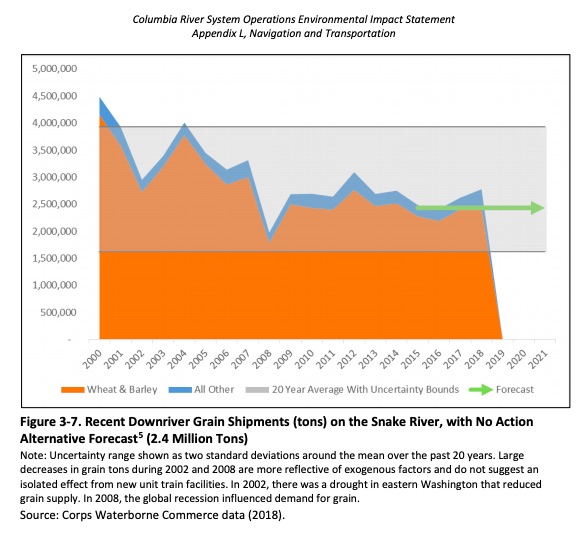forum
library
tutorial
contact

Tour Touts Snake River Dam Benefits,
Other Western Issues
by Matthew Weaver
Capital Press, June 6, 2022
|
the film forum library tutorial contact |

|
Tour Touts Snake River Dam Benefits,
by Matthew Weaver
|
"I am absolutely, 100% convinced that this is a gateway to trying to get rid of every dam on the system,"
-- Kurt Miller, executive director of Northwest RiverPartners, a hydropower advocacy group
 PASCO, Wash. -- Removing the four lower Snake River dams would mean the equivalent of losing enough electricity to power all the households in Seattle, Portland, Spokane and Boise, agricultural stakeholders told members of Congress last week.
PASCO, Wash. -- Removing the four lower Snake River dams would mean the equivalent of losing enough electricity to power all the households in Seattle, Portland, Spokane and Boise, agricultural stakeholders told members of Congress last week.
Removing the dams would take out 1,000 average megawatts of carbon dioxide-free power and 2,500 average megawatts of carbon dioxide-free peaking capacity, said Kurt Miller, executive director of Northwest RiverPartners, a hydropower advocacy group based in Vancouver, Wash.
Washington Rep. Dan Newhouse, chairman of the Western Congressional Caucus, coordinated the tour for caucus members. The tour showcased the river as a source of power and water and a transportation corridor.
The biggest misconception about the dams has to do with the ability of salmon to migrate past the dams, Newhouse said.
Adult salmon and steelhead passage is 96-99% at each dam using fishways, according to the U.S. Army Corps of Engineers. Juvenile survival at the dams is greater than 96% at each dam. Juvenile transport survival to Bonneville is typically 98%.
The lowest survival and least used route for juveniles is turbine passages, according to the corps. A new turbine design program is underway, and the goal is 98% survival.
Proponents of taking out the dams argue that fish passage is inadequate.
Idaho Farm Bureau president Bryan Searle referenced Idaho Republican Rep. Mike Simpson's $33.5 billion proposal to benefit salmon recovery by breaching the dams.
Simpson has been a "good friend" and longtime ally of the Farm Bureau on many challenges, Searle said.
"But there's one item that we definitely disagree (on), and we've been very open -- we sit around the table on a regular basis and we discuss it very openly," he said. "All I can say is, it just appears to me like he has a personal, spiritual love for salmon that I can't even comprehend. As we sit in the room, he'll talk about the most unique species on the face of the earth, that being the salmon. He'll go into a little presentation for 10, 15 minutes. ... Literally, it's an emotional conversation."
Simpson's plan has opened the door for further calls to breach the dams, said Heather Stebbings, executive director of the Pacific Northwest Waterways Association.
The groups advocating dam removal are some of the best-funded non-governmental organizations in the world, with $1.6 billion in assets and revenues, said Miller, of Northwest RiverPartners.
"I am absolutely, 100% convinced that this is a gateway to trying to get rid of every dam on the system," Miller said. "That is what some of these groups are really aiming for."
Leaders of the state Farm Bureaus for the four states in the West worked to put the dams and other industry challenges in context for the lawmakers.
Angela "Angi" Bailey, president of the Oregon Farm Bureau, said she hears the most about natural disaster and "beyond extreme" drought conditions when visiting growers.
"There's a real sense of desperation," she said. "There's not a section of Oregon, north to south, east to west, corner to corner, that wasn't affected by some natural disaster this last year, and the drought conditions continue."
Washington Farm Bureau president Rosella Mosby said farmers are "over-regulated and under-represented."
She pointed to environmental buffers, affordable housing availability for workers and the effect of labor requirements on food banks.
"All of those extras that go to food banks come from overtime hours worked on a farm," she said. "When farmers are considering how to utilize their crews in a field, if you are cutting back on your hours in order to make your margins work, the extras in your cooler, first in, first out, that does not go to the food bank."
Jamie Johansson, president of the California Farm Bureau, talked about a "bureaucrat" recently suggesting using a forest post-wildfire to build affordable housing and store carbon.
"Fabulous idea, you should have been here 40 years ago when they were chaining themselves to the redwood trees and killing the industry," Johansson said. "Problem is, you ran the mills off. You ran off the support industry behind it, and to get that back, it's almost insurmountable when you look at what the costs are going to be. We're going to have those challenges in agriculture. ... If you want to get rid of agriculture, get rid of the support groups and the businesses we need to sell to."
learn more on topics covered in the film
see the video
read the script
learn the songs
discussion forum
